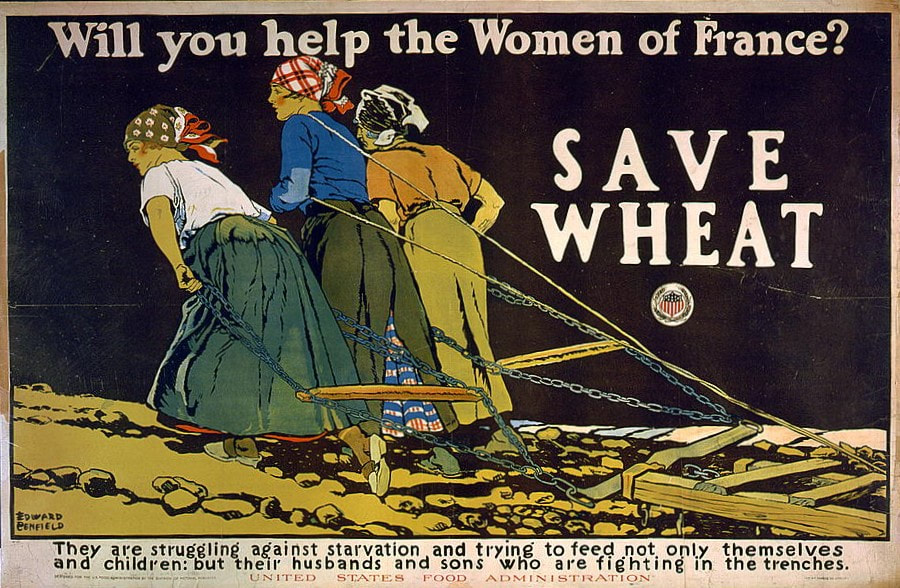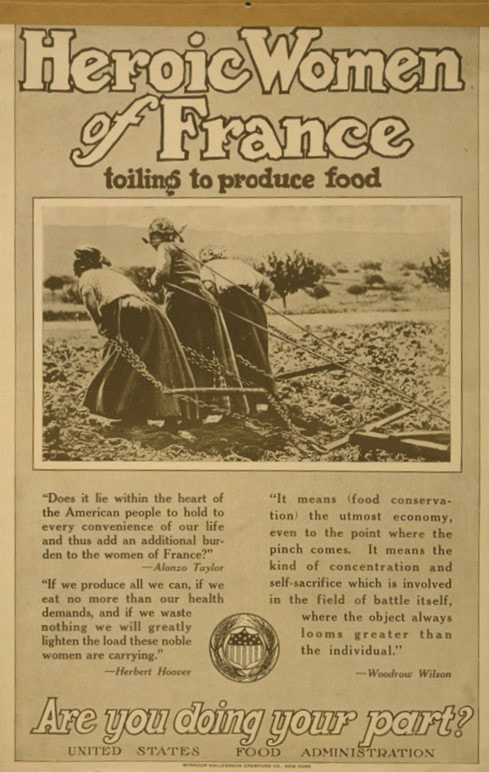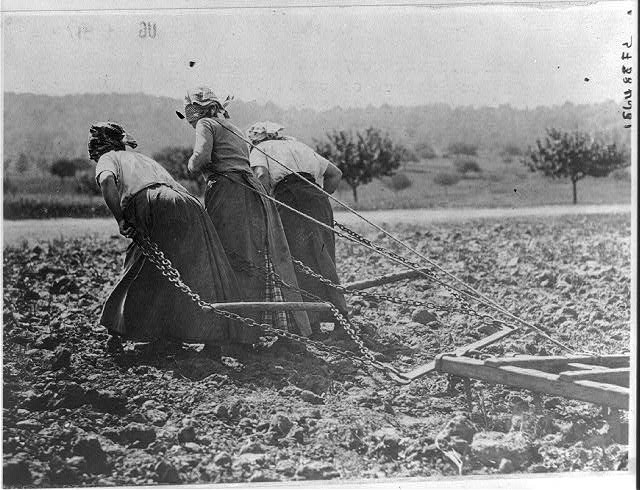|
Hello everyone and welcome to the very first post of World War Wednesdays. I'm aiming to get up to once a week on these, but I might not always make it, just to warn you. I decided I wanted to post on this blog more regularly, and a weekly posting is fairly doable and I LOVE the propaganda posters of both World War I and II, so here we are. I'll also include photographs, cookbooks or recipes, and maybe even WWII radio spots or films (whenever I can find them). I'll post the photos or other primary sources (with links, whenever possible, and caption citations always) and give you a little context to the whys and wherefores of the background of the image. Today, we're starting with one of my favorite and most interesting propaganda posters from the First World War: It reads, "Will you help the Women of France? SAVE WHEAT. They are struggling against starvation and trying to feed not only themselves and children: but their husbands and sons who are fighting in the trenches." Designed by Edward Penfield and published by the United States Food Administration, this propaganda poster was released sometime in 1918, after the United States was well into the War (we joined on April 6, 1917). In it, three French peasant women, in skirts and kerchiefs, have hooked themselves to a plow in lieu of horses. It is a striking image and one that was effective in tugging at American heartstrings, where white Anglo-Saxon women rarely engaged in this kind of brute manual labor. But why wheat? The wheat harvests in the United States in 1915 and 1916 were poor ones, after several years of bumper crops. Geographically, the United States was the closest source of wheat to continental Europe. Canada was of course committed to Britain and other wheat-producing countries like the Ukraine were either engaged in the war themselves or like India were unable to ship to Europe due to the prevalence of German U-Boats. However, since the United States joined the war in April, it was too late to influence farmers to plant more in the spring of 1917. In addition, the United States did not have and would not nationalize agriculture, and could therefore only make recommendations to independent farmers as to what to grow. For most Midwestern farmers, the skyrocketing demand for wheat was driving up prices for their limited supply, and life was good for the first time in many years. They were reluctant to tank those high prices by overproducing. So, it fell to the United States Government, through the United States Food Administration, headed by Herbert Hoover, to persuade ordinary Americans to eat less wheat, along with meat, butter, and sugar, so as to free up these high-calorie, shelf-stable products for consumption by American soldiers and the Allied Forces. Meatless Mondays were a product of the First World War, as were "Wheatless Wednesdays." Although the first poster is more famous, this earlier one features a photograph of the women from which the propaganda poster was made. Here, the poster reads in large letters, "Heroic Women of France toiling to produce food. Are you doing your part?" The interior holds quotes from several notable individuals. "Does it lie within the heart of the American people to hold every convenience of our life and thus add an additional burden to the women of France?" - Alonzo Taylor "If we produce all we can, if we eat no more than our health demands, and if we waste nothing we will greatly lighten the load these noble women are carrying." - Herbert Hoover "It means (food conservation) utmost economy, even to the point where the pinch comes. It means the kind of concentration and self-sacrifice which is involved in the field of battle itself, where the object always looms greater than the individual." - Woodrow Wilson. Produced by the United States Food Administration sometime in 1917, this poster takes a slightly different tack. Still guilt-tripping ordinary Americans, it uses quotes from Food Administration expert Alonzo Taylor, the Food Administrator himself, Herbert Hoover, and President Woodrow Wilson to appeal to Americans' better natures of self-sacrifice. In Progressive Era America, people generally trusted the authority of experts, making this tactic more effective than it perhaps would be today. This striking photograph from sometime in 1916 is the iconic image from which these propaganda posters were derived. The caption reads, "Peasants in the re-taken Somme District work hard without horses or cattle. The Germans in retreat have taken all live stock." Without cattle or horses, these French women, having survived the battles of the infamous Somme, are trying to return to some semblance of normal life, hitching themselves to the plow to ensure a harvest for winter.
Or so it seems. It is unclear whether or not this photo is staged for effect. It is entirely possible that it is legitimate, but it is just as possible that it has been staged as propaganda. The women do appear to be pulling, however - the lines are fairly taut, and they appear to be wearing everyday clothing, not costumes. Regardless of whether or not the photo is true to life or staged, this image had a striking impact on Americans (and Canadians) in helping the United States Food Administration convince them to reduce consumption of wheat for the duration of the war.
0 Comments
Your comment will be posted after it is approved.
Leave a Reply. |
AuthorSarah Wassberg Johnson has an MA in Public History from the University at Albany and studies early 20th century food history. Archives
July 2024
Categories
All
|




 RSS Feed
RSS Feed